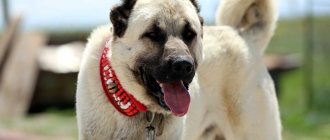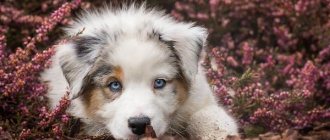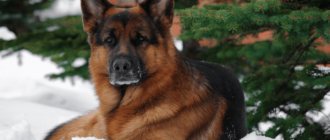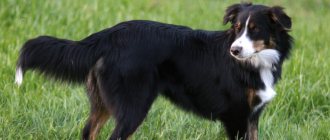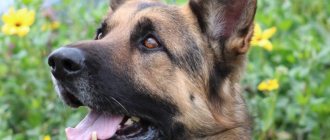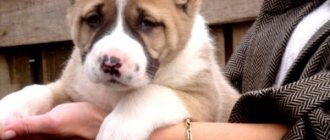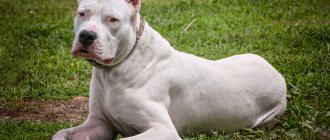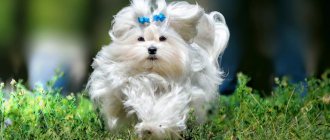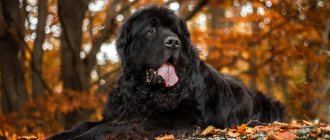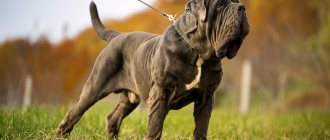The Turkish or Anatolian Shepherd is a strong, confident and calm dog with a wise and insightful gaze. Under her protection, you can safely leave your home and property or entrust her with the protection of your child. After all, a devoted pet will carry out the owner’s instructions until his last breath and will not flinch in the face of any opponent, even those superior to him in strength.
History of the origin of the breed
The distant ancestors of these dogs are depicted on Assyrian bas-reliefs, and their history goes back more than six thousand years. In Turkey, their historical homeland, powerful and hardy animals have helped shepherds guard their flocks of goats and sheep for centuries.
Although shepherd dogs of this breed are called Anatolian, Turkish experts do not recognize this name, calling the dogs Kangal, which translates as black-headed.
What is noteworthy is that purebred Kangals in Turkey are considered a national treasure, and their export from the country is strictly prohibited. But the taboo does not apply to puppies born from a marriage of purebred Kangals and other breeds, which allowed Europeans to take out several mestizos for further selection work with them.
Kangals were used to guard herds of sheep and goats
The official registration of dogs occurred relatively recently - in 1990, so I consider the Anatolian Shepherd breed to be young, despite their centuries-old history. In the same year, the first club of Turkish Shepherd lovers was founded, but so far the animals cannot boast of worldwide fame and popularity among dog lovers.
Interesting Facts
- The breed is currently recognized as a national treasure of Turkey, it can be seen on advertising brochures, badges, among souvenirs and on coins. In some Turkish families, there is a custom to give the family a Karabash puppy for the birth of their first child.
- Shepherds often tell stories that Kangal Shepherds, when they find a sheep, selflessly protect it for several days, going without food or drink.
- In Namibia and Kenya, Kangal Shepherds are used to protect livestock from cheetahs. And the cheetah, for your information, is the fastest predator on the planet. Where these dogs have been employed, livestock losses have been significantly reduced.
- The protective coloring of the karabash had another amazing feature. Thanks to such wool, the dog did not frighten the sheep with its appearance, to the point that they allowed it to nurse their lambs.
- Ear cropping of a Kangal Shepherd is considered illegal in some countries, such as the UK.
- Anatolian Shepherds often choose a place on a hill to survey the surroundings, and they generally try to lead the family pack. The Kangal may not accept a second large dog, but a small dog or any other animal will be protected and loved.
Appearance and description of the breed
Anatolian Shepherds are large and powerful dogs that carry themselves with dignity and self-confidence. And, despite their size and apparent heaviness, the animals are very dexterous and fast and have a well-developed reaction.
Appearance:
- The animals have a proportional build, with a straight back and a wide chest. The height of adult males reaches seventy-five to eighty centimeters, and weight ranges from fifty to sixty kilograms. Females are more graceful and slightly smaller than males. The body length of females does not exceed seventy centimeters, they weigh from forty to fifty-five kilograms;
- the legs are long, straight and muscular;
- the tail is medium length, flexible and fluffy;
- Dogs have a large, wide head with a convex forehead, which smoothly transitions into the nasal part. The eyes are almond-shaped, chocolate or amber-golden in color. Animals have hanging ears of medium length, triangular in shape;
- The Anatolian's coat is straight and short with a thick, dense undercoat. The fur on the neck and chest is longer and fluffier than on the rest of the body;
- The breed standard allows almost any color of Anatolian Shepherds. Dogs may have cream, blue-gray, reddish or light brown fur. The main condition is that the nasal area, cheeks, eyebrows and ears must be painted in a dark shade.
The breed was officially registered in 1990
Dossier
Let's start with some basic information about the Anatolian Shepherd.
- Adult height: 72-77 cm (females); 77-86 cm (males).
- Weight: reaches 68 kg.
- Characteristic color: black, brindle, can contain up to three colors at the same time.
- Coat length: short; strong and straight.
- Life expectancy: 13-15 years.
- Advantages of the breed: these dogs make wonderful guards. They are smart, independent and always ready to protect their owner.
- Difficulties of the breed: This dog does not necessarily need to build an enclosure, but it does need a lot of space to roam. Not suitable for keeping in an apartment.
- Average price: 600$ – 800$.
- Classification: large dogs, guard dogs, mountain dogs.
Character and behavioral characteristics
The calm and serene appearance of the Anatolian Shepherd is deceiving. It may seem that the dog is lying calmly near the porch of the house, showing absolutely no interest in passing people and passing cars, but this is a skillful disguise.
In fact, the animal carefully examines its surroundings and never loses its vigilance. And as soon as someone approaches the property under the dog’s control, the pet reacts with lightning speed to a potential threat. Not a single stranger will be able to penetrate unnoticed into the territory patrolled by a shepherd dog, therefore, as a guard, she has no equal.
The protective instincts in these animals are inherent in nature and, upon first getting into the house, the Anatolian Shepherd puppy will waste no time exploring the area entrusted to it. After examining the territory, the pet will become acquainted with all family members and other pets, becoming their personal patron and protector, the protection of which he considers his main purpose.
These dogs are distinguished by their boundless devotion and loyalty to their owners, but always remain balanced and cold-blooded. They do not show strong emotions, and you should not expect that the pet, when meeting its owner, will begin to show joy with barking and wagging its tail.
Kangals get along only with small pets, in which they do not see competition.
Turkish Shepherds are distrustful and wary of strangers. The dog will carefully examine each visitor to make sure that the stranger does not pose a threat to the owner or her possessions. In the presence of an animal, guests should behave carefully and carefully, because a sudden movement can provoke the dog to attack, and even the owner’s order will not prevent it from rushing at the troublemaker. Anatolians do not tolerate the touch of strangers, so it is worth warning guests that petting the dog is prohibited, otherwise the consequences could be disastrous.
As for other pets, shepherds will get along with cats or small dogs, perceiving them as members of their “herd” that need to be protected. But the Anatolian will not get along with dogs of large breeds, for example, a German Shepherd or a St. Bernard, because in their eyes they are rivals for leadership and territory. It is worth noting that dogs do not show aggression or malice towards their own relatives, and will get along well in the same house.
Important: Anatolian Shepherds love to climb to high places in order to survey the surroundings from there and take in the entire territory that belongs to them.
Interaction with children
Anatolian Shepherds are patient with children, but you should not expect the dog to become a fun play partner for your child. After all, even at an early age, this breed is not prone to games and pranks like other puppies.
For Kangal, a child is an object of protection
For an Anatolian, a child is an object of protection and the baby can be safely left under the supervision of such a vigilant protector. The dog will not let anyone near the child and will not let him out of the protected area.
The best nicknames for Kangal
Kangals fully deserve proud and beautiful names. Therefore, the choice of nickname should be approached with the utmost seriousness. There is no need to call your pet funny names that degrade its dignity. The name should be as majestic as the breed itself. You can pay attention to Turkic names. So, Kangal boys can be called:
- Adalat - justice;
- Agalak - power;
- Batyr - hero;
- Demir - iron;
- Kamal - fortress;
- Sultan is a ruler.
Suitable names for Kangal girls:
- Akhtar - comet;
- Gaya - rock;
- Danara - talisman;
- Jita - song;
- Oisha - lunar;
- Uni is a spring.
Teaching methods and training
When deciding to get an Anatolian Shepherd, the owner should prepare for the fact that it will take a lot of time and effort to raise and train the animal. These dogs are not distinguished by their obedient and flexible character and must be taught to obey from an early age. If you do not raise the puppy properly, the pet will become uncontrollable and will make its own decisions, ignoring the orders of the owner.
Patience, calmness and perseverance are the necessary qualities in raising an Anatolian puppy
Dogs of this breed are smart and quick-witted and have excellent memory, thanks to which they quickly remember commands, but this does not mean that they will obey orders unquestioningly. After all, the Anatolian will carefully analyze each command of the owner, and if he considers it meaningless, then no circumstances will force the animal to carry out the instructions.
To teach a dog obedience, the owner must make it clear that he is the leader and authority. Once you show weakness and allow your pet to do as he pleases, it will no longer be possible to achieve obedience from him. Therefore, it is necessary to repeat each command until the animal completes it.
It is also worth considering the innate hostility of Anatolian Shepherds towards strangers and other animals. And it will depend only on the owner how the pet will behave in the presence of guests. After all, a dog that is not accustomed to discipline may refuse to allow people into its territory, even if they came accompanied by the owner. And along with the basic commands - “sit” and “come to me”, it is very important to teach your pet to obey orders - “place” and “no”. Otherwise, the pet itself will decide who is worthy of entering the house, and the owner will only have to come to terms with the choice of the animal.
Mating
Since Anatolian Shepherds develop quickly, they become capable of breeding already at 8-12 months. It is believed that this age is early, the dog’s body will not be able to conceive, bear and give birth to strong offspring. Therefore, it is recommended to do the first mating at 20 months for females and at 24 months for males. Physiologically, the female is capable of breeding on the 3rd estrus .
It is recommended to bring dogs together in the male's territory. There he will feel like a master, which will help the dog to be more active.
Care and maintenance
Caring for the unpretentious and undemanding Anatolian Shepherd will not require much effort from the owner.
Anatolians are unpretentious in grooming, but require long walks
Hygiene procedures:
- there is no need to brush the dog regularly, and such a procedure is only needed during the period of intense molting of animals, which occurs in spring and autumn;
- The pet also does not need frequent bathing, so water treatments for the pet are arranged no more than two or three times a year;
- the eyes and inner surface of the ears are periodically cleaned of secretions and accumulated dirt;
- Plaque can form on the teeth of animals, so the dog’s teeth are regularly examined and, if necessary, cleaned with a special brush.
Conditions of detention:
- Anatolian Shepherds feel comfortable outdoors at any time of the year. But a comfortable and spacious enclosure should be equipped for your pet, where he can rest and take shelter during severe frosts;
- the dog needs long, frequent walks and physical activity;
- it is necessary to devote enough time to communicate with your pet and to educational disciplinary activities.
Important: these animals do not tolerate restrictions of freedom, so putting them on a chain is extremely undesirable, otherwise the dog will become nervous, irritable and aggressive.
Health and Lifespan of the Anatolian Shepherd Dog
This breed is distinguished by its endurance and excellent health. Dogs calmly tolerate temperature changes, adapt to changes in environment without stress, and are not afraid of intense physical activity.
The nose area, cheeks, brow ridges and ears should be painted in a dark shade.
In general, these are healthy animals with strong immunity that are not susceptible to hereditary diseases.
But like other large dog breeds, Anatolians are prone to hip dysplasia, so calcium should be added to their food.
Older animals often develop tumors, especially at the site of injury, and the owner should more closely monitor the health of an aging pet.
On average, Anatolians live between ten and twelve years.
Important: dogs of this breed are very sensitive to anesthesia and may not tolerate surgery performed under general anesthesia.
general characteristics
Representatives of this breed are distinguished by their tall stature, long legs, and significant weight. The height and weight of this excellent breed differs by gender. The male's height is 75–82 cm, and his weight is from 49 to 66 kg. The female's height is 70–78 cm and her weight ranges from 39 to 54 kg. The Anatolian Shepherd has short, thick hair and a thick undercoat.
The Anatolian Shepherd's coat is straight and close-fitting. On the neck, withers and tail the hair is thicker, on the legs and ears it is almost absent. The color of representatives of this dog breed is one color. Shades of color can range from cream to fawn. Also characteristic of this breed is a black muzzle and black ears.
The skull of the Anatolian Shepherd is large and wide. Between the ears the skull is flat. The lips are dark, usually black, slightly drooping, and the nose is also black. The eyes are small and located far from each other. The eyes are outlined in black. The ears are triangular in shape and medium in size, with rounded ends. The Anatolian Shepherd has a scissor bite. The tail of this dog breed is straight and slightly curved.
Breed standard
The Kangal Shepherd is an unusually powerful dog, large in size, but at the same time looks light and slender. The physique is proportional, muscles are strongly developed in all parts of the body.
The height of an adult sexually mature kangal reaches 75-88 cm , weight is about 50-60 kg . Males are significantly taller and heavier than females.
A voluminous head with a wide skull rests on a strong, thick neck with a slight bend and slight dewlap. The drooping, triangular ears are not too large. Cupping is allowed.
Almond-shaped eyes are brown with black rims. The size of the eyes is proportional to the size of the skull (medium or large). The eyelids should not be sagging.
The line of the muzzle is sloping (from the stop to the nose). The length of the muzzle is shorter than the skull. The nose is large.
The jaw system is powerful. The teeth are strong. The fangs are large. Scissor bite. A reverse scissors or straight bite is also allowed. The lips are black, slightly drooping.
The croup is not too long, with an inclination of up to 30 degrees. The body should not be flat on the sides. The back is of medium length, the topline with a slight convexity in the lumbar region. The hemline is tightened. The chest is deep and long.
The limbs are long, smooth, and muscular. The hock joints are strong and wide. The paws are strong and the paw pads are thick. Fingers are curved. Amputation of the dewclaws is not necessary.
A step at low speed is an amble. During movement, the karabash lowers its head to the level of the back. This way the head, neck and back are on the same level. From the outside it seems that the kangal is not walking, but sneaking.
The tail is not docked. It is long and straight. If the dog is excited, he raises his tail high and curls it in a ring.
The skin of the Anatolian Shepherd is without folds and not too thick. A slight dewlap on the neck is not considered a defect.
The coat is short, dense, and hard to the touch. There is a thick undercoat.
Kangal colors range from fawn to wolf. A black mask is required on the face.
Kinds
The concept of "Anatolian Shepherd" was not accepted by the Turks because they also have other shepherds that fall under this definition.
- The closest relative of our Anatolian is the Kangal Karabash; the breed standard was developed in 2001 in Turkey near Sivas, which is why it is called Sivas Kangal. But the breed is not accepted as an independent breed in the world.
For a long time, many people mistakenly called the Anatolian karabash kangal. But recently, in order to avoid confusion, a single name was adopted for animals of this breed. In practice, they are now considered inbreeding species. Unlike the Anatolian carabash, the galangal has only one color - gray-fawn with a black mask.
Diet and feeding regime
The Anatolian Shepherd cannot be called picky when choosing food. These animals happily eat any food offered by the owner.
If dry food is chosen as food, then you should give preference to premium food, which contains vitamins, beneficial additives and microelements.
When choosing natural food, you must remember that the main daily dish should be porridge with pieces of boiled or raw meat. You can diversify the menu with fermented milk products, vegetables, offal and sea fish.
Anatolian Shepherds eat immoderately, as a result of which they are prone to overweight and obesity. To avoid this, you should establish a feeding regime, giving the dog food twice a day, at strictly prescribed times and observing the dosage of portions.
It is forbidden to feed your pets sweets, smoked meats, fish and chicken bones and fatty salty foods.
The cost of a puppy of this breed
Purebred Kangals are considered the property of Turkey and are prohibited from being exported from the country
. Not many kennels are engaged in breeding Anatolian Shepherds, so their cost is quite high. For a purebred puppy with a pedigree and documents, the future owner will have to pay from thirty to sixty thousand rubles.
But babies with defects (non-standard color, white spots on the body, long hair) are much cheaper. And if the owner does not plan for his pet to participate in exhibitions and simply wants to purchase a guard for his home, then he can buy a puppy for ten to twenty thousand rubles.
Owner reviews
How do owners of Anatolian Shepherds characterize their pets?
Veronica: a great dog for home protection
.
The most valuable qualities of this dog are intelligence, endurance and devotion. Yes, she is not as obedient as other breeds, but she is a reliable and loyal pet. Our dog is brave and determined and I never worry that thieves will break into the house if I have to be away for a long time.
Evgeniy: this is a calm and intelligent pet.
We were given an Anatolian Shepherd puppy as a gift, and I immediately started looking for information about her. Honestly, I didn’t like the fact that the dog’s character was independent and stubborn, but as it turned out, this doesn’t apply to our Emir. He is smart, intelligent and balanced, and even made friends with our daughter’s favorite Yorkshire terrier and condescendingly watches as the baby runs around barking loudly throughout the house and area.
The Anatolian Shepherd is not a working dog with a playful and cheerful disposition and is unlikely to be a fun play companion. But over the centuries, she has regularly coped with the role of watchman and protector and is always ready to stand guard over peace and protect the lives of those to whom she is faithful and devoted with all her heart and soul.
